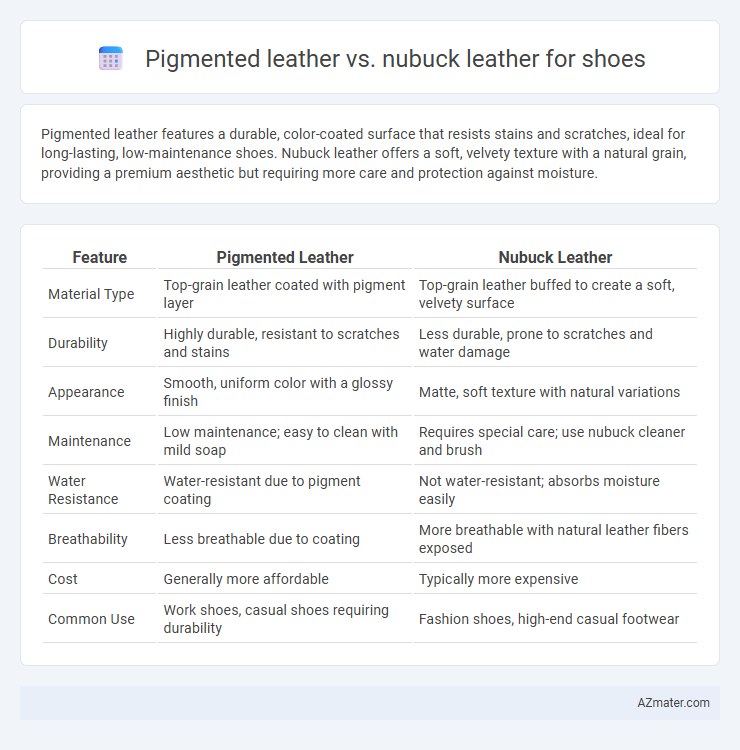Pigmented leather features a durable, color-coated surface that resists stains and scratches, ideal for long-lasting, low-maintenance shoes. Nubuck leather offers a soft, velvety texture with a natural grain, providing a premium aesthetic but requiring more care and protection against moisture.
Table of Comparison
| Feature | Pigmented Leather | Nubuck Leather |
|---|---|---|
| Material Type | Top-grain leather coated with pigment layer | Top-grain leather buffed to create a soft, velvety surface |
| Durability | Highly durable, resistant to scratches and stains | Less durable, prone to scratches and water damage |
| Appearance | Smooth, uniform color with a glossy finish | Matte, soft texture with natural variations |
| Maintenance | Low maintenance; easy to clean with mild soap | Requires special care; use nubuck cleaner and brush |
| Water Resistance | Water-resistant due to pigment coating | Not water-resistant; absorbs moisture easily |
| Breathability | Less breathable due to coating | More breathable with natural leather fibers exposed |
| Cost | Generally more affordable | Typically more expensive |
| Common Use | Work shoes, casual shoes requiring durability | Fashion shoes, high-end casual footwear |
Introduction to Pigmented and Nubuck Leather
Pigmented leather features a durable, protective coating that enhances color uniformity and resistance to stains, making it ideal for long-lasting shoe exteriors. Nubuck leather is created by sanding the outer layer of full-grain leather, resulting in a soft, velvety texture prized for its natural, matte finish and breathability. Both types cater to different footwear aesthetics and maintenance preferences, with pigmented leather favoring durability and nubuck offering a premium, tactile experience.
What is Pigmented Leather?
Pigmented leather is a type of leather coated with a durable pigment layer, providing a uniform color and enhanced resistance to wear, stains, and UV damage, making it ideal for shoes that require longevity and easy maintenance. Unlike nubuck leather, which features a soft, suede-like surface achieved by sanding the grain side, pigmented leather has a smooth, sealed finish that masks natural imperfections. This coating process ensures consistent appearance and greater protection, suitable for everyday footwear exposed to varying conditions.
What is Nubuck Leather?
Nubuck leather is a top-grain cattle leather that has been sanded or buffed on the grain side to create a soft, velvety surface with a fine nap, offering a luxurious texture and matte finish. Unlike pigmented leather, which is coated with a protective pigmented layer for enhanced durability and stain resistance, nubuck is more breathable but requires careful maintenance to prevent staining and water damage. Ideal for stylish, high-end shoes, nubuck emphasizes natural leather qualities and develops a unique patina over time.
Appearance and Texture Differences
Pigmented leather features a uniform color and a smooth, glossy surface due to its pigmented or painted finish, making it highly resistant to stains and easy to clean. Nubuck leather appears more natural with a velvety texture created by sanding the outer layer of the hide, offering a soft, matte finish that shows variations in color and may develop a unique patina over time. The pigmented leather's sleek appearance contrasts with nubuck's suede-like feel, influencing the shoe's aesthetic and maintenance requirements.
Durability and Wear Resistance
Pigmented leather features a durable, protective coating that enhances wear resistance by shielding the surface from scratches and stains, making it ideal for high-traffic shoes. Nubuck leather, with its sanded surface, offers a soft texture but is more susceptible to scuffs and water damage, requiring additional care to maintain its appearance. For long-lasting durability and minimal maintenance in footwear, pigmented leather outperforms nubuck due to its robust finish and resistance to daily wear.
Comfort and Breathability
Pigmented leather features a durable coating that enhances stain resistance but can reduce breathability, making it less ideal for extended wear comfort. Nubuck leather is sanded on the grain side, offering a soft, breathable surface that improves moisture absorption and enhances overall comfort in shoes. The porous nature of nubuck allows better air circulation, which helps regulate foot temperature and reduces sweating compared to pigmented leather.
Maintenance and Cleaning Requirements
Pigmented leather features a durable polyurethane coating that resists stains and moisture, requiring only regular wiping with a damp cloth to maintain its appearance. Nubuck leather, with its sanded surface, demands gentle brushing with a soft brush and specialized nubuck cleaner to prevent damage and maintain its soft texture. Both types benefit from regular application of suitable conditioners, but pigmented leather generally offers easier maintenance and greater resistance to environmental wear.
Stain and Water Resistance Comparison
Pigmented leather features a durable, synthetic coating that provides superior stain and water resistance, making it easier to maintain and less prone to discoloration. Nubuck leather, being sanded on the grain side to create a soft, velvet-like surface, is more porous and susceptible to staining and water damage without proper sealing and treatment. For shoe applications requiring high resistance to environmental factors, pigmented leather offers enhanced protection and longevity compared to nubuck.
Cost Implications and Value
Pigmented leather typically costs less due to its surface coating, offering greater durability and resistance to scratches, making it a cost-effective choice for everyday shoes. Nubuck leather requires more intensive processing and maintenance, elevating its price but providing a distinct soft texture and premium appearance that enhances shoe value. Investing in nubuck shoes often yields long-term aesthetic appeal, while pigmented leather shoes offer practical affordability and sturdiness.
Choosing the Best Leather for Your Shoes
Pigmented leather features a durable, uniform coating that resists stains and fading, making it ideal for shoes requiring low maintenance and long-lasting color vibrancy. Nubuck leather, sanded on the grain side to create a soft, velvety texture, offers a premium aesthetic but demands careful care to prevent water spots and staining. Selecting the best leather for your shoes depends on balancing durability and appearance, with pigmented leather favored for everyday wear and nubuck preferred for stylish, refined footwear.

Infographic: Pigmented leather vs Nubuck leather for Shoe
 azmater.com
azmater.com